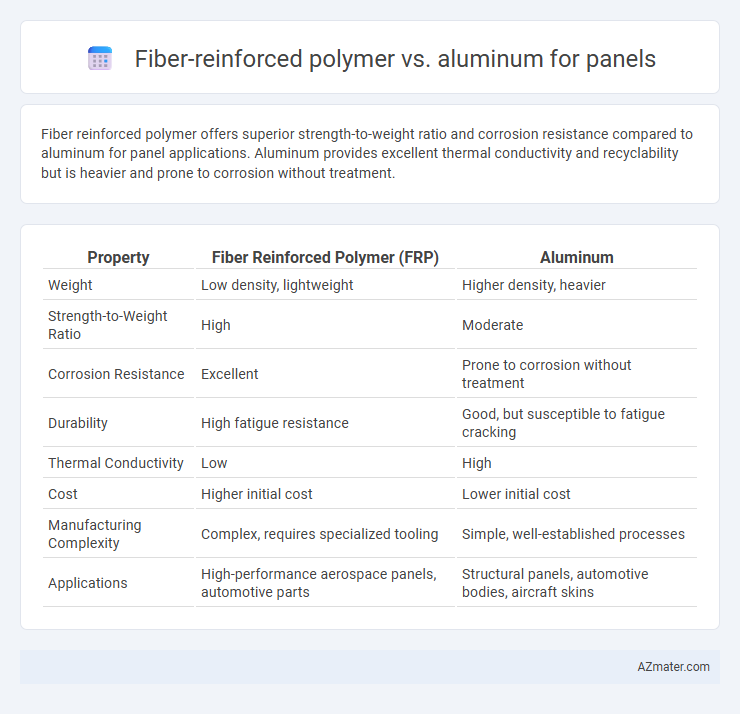Fiber reinforced polymer offers superior strength-to-weight ratio and corrosion resistance compared to aluminum for panel applications. Aluminum provides excellent thermal conductivity and recyclability but is heavier and prone to corrosion without treatment.
Table of Comparison
| Property | Fiber Reinforced Polymer (FRP) | Aluminum |
|---|---|---|
| Weight | Low density, lightweight | Higher density, heavier |
| Strength-to-Weight Ratio | High | Moderate |
| Corrosion Resistance | Excellent | Prone to corrosion without treatment |
| Durability | High fatigue resistance | Good, but susceptible to fatigue cracking |
| Thermal Conductivity | Low | High |
| Cost | Higher initial cost | Lower initial cost |
| Manufacturing Complexity | Complex, requires specialized tooling | Simple, well-established processes |
| Applications | High-performance aerospace panels, automotive parts | Structural panels, automotive bodies, aircraft skins |
Introduction to Fiber Reinforced Polymer and Aluminum Panels
Fiber reinforced polymer (FRP) panels consist of a composite material made from a polymer matrix reinforced with fibers, typically glass, carbon, or aramid, offering high strength-to-weight ratio and corrosion resistance. Aluminum panels, composed of lightweight metal with excellent thermal conductivity and recyclability, provide durability and ease of fabrication in construction and industrial applications. Both materials serve as versatile panel solutions, with FRP favored for its superior chemical resistance and aluminum valued for its structural rigidity and longevity.
Material Composition and Properties
Fiber reinforced polymer (FRP) panels consist of a polymer matrix combined with high-strength fibers such as glass, carbon, or aramid, offering a lightweight and corrosion-resistant alternative to metals. Aluminum panels, composed primarily of aluminum alloys, provide excellent strength-to-weight ratio and superior thermal conductivity but are prone to corrosion without protective coatings. FRP exhibits high tensile strength, flexibility, and resistance to chemical degradation, while aluminum panels deliver greater impact resistance and recyclability, making material composition pivotal in selecting the appropriate panel for specific structural and environmental demands.
Weight Comparison: FRP vs Aluminum
Fiber reinforced polymer (FRP) panels are significantly lighter than aluminum panels, often weighing up to 50% less. This weight advantage enhances ease of installation and reduces overall structural load, making FRP ideal for applications demanding low weight and high strength. Aluminum, while lightweight compared to traditional metals, typically has a density around 2.7 g/cm3, whereas FRP densities can be as low as 1.6 g/cm3 depending on the fiber and resin combination used.
Strength and Durability Differences
Fiber reinforced polymer (FRP) panels exhibit superior corrosion resistance and fatigue strength compared to aluminum, making them highly durable in harsh environments. Aluminum panels offer excellent strength-to-weight ratios but are more prone to oxidation and mechanical wear over time. FRP's composite structure enables higher impact resistance and longer service life, whereas aluminum requires frequent maintenance to preserve structural integrity.
Corrosion Resistance and Environmental Impact
Fiber reinforced polymer (FRP) panels exhibit superior corrosion resistance compared to aluminum, as FRP materials are inherently non-metallic and immune to rust and chemical degradation. The production and disposal of FRP generate fewer greenhouse gas emissions and involve less energy-intensive processes than aluminum, which requires mining and smelting, contributing to higher environmental impact. FRP's longevity and minimal maintenance further reduce environmental footprint by extending service life and lowering the need for replacements relative to aluminum panels.
Cost Considerations and Economic Efficiency
Fiber reinforced polymer (FRP) panels typically offer lower lifecycle costs compared to aluminum due to reduced maintenance requirements and superior corrosion resistance, despite a higher initial material expense. Aluminum panels incur ongoing costs from frequent upkeep and potential replacements caused by oxidation and structural degradation. Economic efficiency favors FRP when evaluating total ownership cost over time, especially in environments prone to corrosion and harsh weather conditions.
Fabrication and Installation Processes
Fiber reinforced polymer (FRP) panels offer superior flexibility and lightweight properties, simplifying fabrication through processes like molding and curing, which reduce the need for heavy machining compared to aluminum. Aluminum panels require precise cutting, welding, and fastening, often necessitating specialized equipment and skilled labor to maintain structural integrity. Installation of FRP panels is typically faster due to their corrosion resistance and ease of handling, whereas aluminum panels may require additional treatments and careful alignment to prevent galvanic corrosion and ensure durability.
Thermal and Electrical Conductivity
Fiber reinforced polymer (FRP) panels exhibit significantly lower thermal conductivity, typically around 0.2 W/m*K, compared to aluminum panels, which have high thermal conductivity near 205 W/m*K, making FRP ideal for insulation applications. In terms of electrical conductivity, aluminum boasts excellent conductivity at approximately 3.5 x 10^7 S/m, whereas FRP is an electrical insulator with conductivity close to zero, providing superior electrical isolation. These properties make FRP panels preferable where reduced heat transfer and electrical insulation are required, while aluminum panels are advantageous for applications demanding rapid heat dissipation and electrical conduction.
Applications in Various Industries
Fiber reinforced polymer (FRP) panels offer superior corrosion resistance, lightweight properties, and high strength-to-weight ratios, making them ideal for aerospace, automotive, and marine industries where durability and weight reduction are critical. Aluminum panels provide excellent thermal conductivity, recyclability, and structural integrity, widely used in construction, transportation, and electrical enclosures for their ease of fabrication and cost-effectiveness. Industries often select FRP for chemical plants and offshore platforms due to its resistance to harsh environments, while aluminum dominates in architectural facades and automotive body panels for its balance of strength and formability.
Summary: Choosing the Right Panel Material
Fiber reinforced polymer (FRP) offers superior corrosion resistance and lightweight properties compared to aluminum, making it ideal for environments prone to moisture and chemical exposure. Aluminum provides excellent strength-to-weight ratio and recyclability, favored in applications requiring durability and environmental sustainability. Selecting the right panel material depends on factors like exposure conditions, mechanical requirements, and budget constraints to optimize performance and longevity.

Infographic: Fiber reinforced polymer vs Aluminum for Panel
 azmater.com
azmater.com